Hallway colors: color options and beautiful examples

Color for the hallway in the apartment and house plays a huge role. First of all, this room is a kind of face of the house, so its design forms the impression of the home as a whole. In addition, small parameters of the corridor are very common. Therefore, the color scheme and design are aimed primarily at correcting the visual imperfections of a small room. The lack of natural light is another feature that requires competent selection of color combinations in the interior.
It is very important to choose the optimal range for decoration, furniture and decor, especially if you want to make a design in an original style, in unusual colors.
Successful combinations
First of all, you need to decide in which direction you will shape the composition, make it classic light or non-standard dark. If the first option is closer to you, the designers recommend taking into account the following nuances.
- The lack of natural light requires the attraction of not too bright, but expressive tones. Yellow, mint, pink will do. They look best in a company with a snow-white scale, especially since this combination will visually enlarge the room.


- Furniture in soft monochrome is a very effective solution for a bright hallway. And the beige and milky scale in the patterns of the walls will hide the imperfections of the surfaces. It is also a very sophisticated design option.


- Combined, red and gray look very dynamic, relevant and non-trivial. This trend is at its peak because gray perfectly balances the fieryness of red or orange. At the same time, the whole composition looks dignified and not at all vulgar.This combination works especially well for visually correcting proportions. For example, if you decorate the far wall of a narrow hallway in a red version, the room will become more square. Redness can be successfully replaced with a tint of cherry and wine and berry range.


- Very rarely, blue shades are used in the design of corridors, but in vain. Turquoise, heavenly scales are able to bring freshness, freedom and a lot of air into a cramped interior.


- Light greens are ideal for many styles. The most trending shades: pistachio, olive. They look gorgeous in a company with a coffee range, for example, latte.


If your goal is a dark hallway, such points should be taken into account here.
- Dark color options in the hallway are not such a frequent choice, since they optically make the room smaller.
- Always combine dark shades with lighter ones. For example, combine purple with lilac, decorate the brown hallway in chocolate and milk tones.
- The light floor and decor details look great against a dark background.
- Skip a dark hallway if the room is small.
- The same applies to the classic style - dark tones do not suit him, be sure to take into account the general style and color in the apartment.

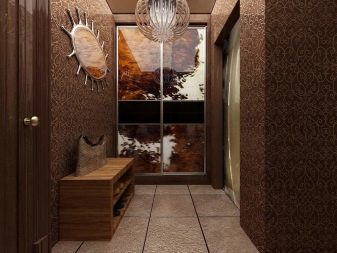


Color and style selection
Not only the shades of the selected furniture, decorative elements and finishes should be harmoniously combined. All these details should form a single stylistic composition, fit and match each other.
Before you finally decide on a color, choose a style that suits you. And already within the framework of the concept, make a decision on the color. Almost all existing styles are suitable for the hallway.
However, there are a number of areas worth considering first..
- Classic, modern. These styles are similar in color scheme. First of all, these are light shades: white, sand, beige, cream and brown. If you want a universal painting, choose white, for a corridor this is a great option.

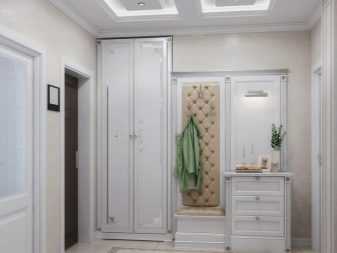
- Baroque. This luxurious style is especially suitable for a large room. Saturated shades are an integral part of it, especially pink in combination with white and gilding.


- Rococo. This concept also emphasizes the elitism of the interior items. But the color in it is calmer - brown palette, beige, cream. Gold decor will perfectly complement these shades.


- Empire style. This style does not tolerate halftones; bright shades are taken as a basis. It is best to opt for greens, red, blue. Gold is essential here.


- Minimalism... The most laconic and austere style, the decor in which is completely absent. The color scheme matches the concept: neutral, laconic. It is optimal to use combinations of white, black, gray, brown, cream.


- Pop Art. A bright extraordinary direction in which calm tones are inappropriate. Catchy, flashy, juicy shades of sand, yellow, orange, pink are perfect.


- High tech... A style that prioritizes functionality. The color scheme is restrained, mostly gray. Metallic shine and gloss complement this trend well.


- Scandinavian. A very popular style, which is distinguished by the simplicity of forms and the softness of the chosen palette. White, gray, blue with bright rare splashes form the basis of the style.


- Provence. The style of the French province is distinguished by elegance, freshness, floral motives and pastel color combinations.
Feel free to combine beige or white with mint, lavender, faded lemon, light blue and pale pink.

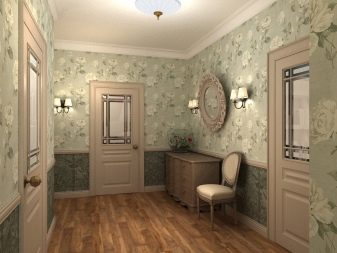
- Country... Another rustic style, in which the main core is naturalness and naturalness. Natural shades are in priority: greens, blue, brown, all shades of wood.


Finishing
The ceiling in the hallway is optimally decorated in snow-white colors. Gloss is better suited for modern styles, matte finish will give the classic design status, respectability.Complex ceiling structures, bright colors are not recommended for the hallway. To cover the floor, they most often choose ceramic tiles or porcelain stoneware, high-quality linoleum. You can use parquet, laminate or a combination of them with tiles. The color of the floor should be either darker or lighter than the walls, not to merge with them. When it comes to wall decoration, there are many good options.
- Wallpaper... The most versatile solution. Choose wallpaper that is moisture-resistant and easy to clean. The color scheme should be matched to the style.
- Dye. The most practical option, it is very easy to update such a coating.
- Water-based coating - pretty persistent. Most often, this paint is snow-white, but with the help of a color scheme it is easy to fix it.
Remember that the color of the walls should not be darker than the furniture, the walls are the background for other objects, so in order to present them favorably, you need to make the walls a little lighter.



Narrow and small hallways
This is a common problem with layouts. but visually, many imperfections can be corrected with the help of color, light and decor:
- organize the right lighting system, which is not limited to one chandelier;

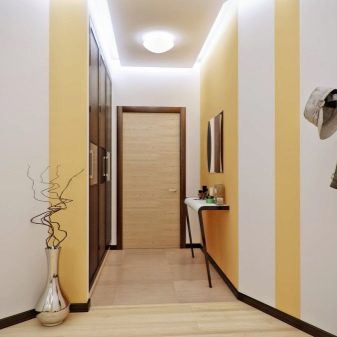
- choose simple shades for wall decoration, give up complex combinations, large patterns and ornaments;

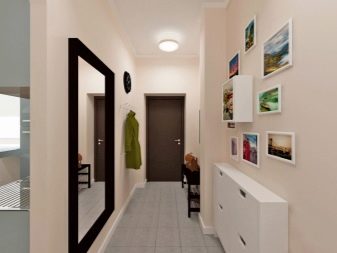
- monochrome is an ideal solution for any style, but you should not decorate everything in one color;


- cold pastel visually expands the space;


- a dark decorative surface with a white pattern will perfectly enliven the interior;


- do not strive for monotony, such designs are very tiring, be sure to dilute the composition with interesting bright details;


- use a gradient - a smooth transition of shades in the design;

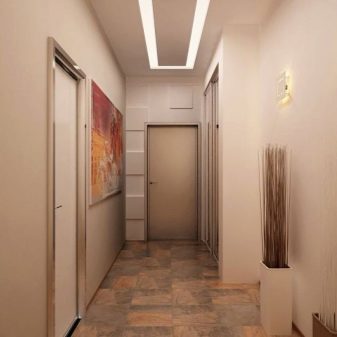
- horizontal lines make the room wider;

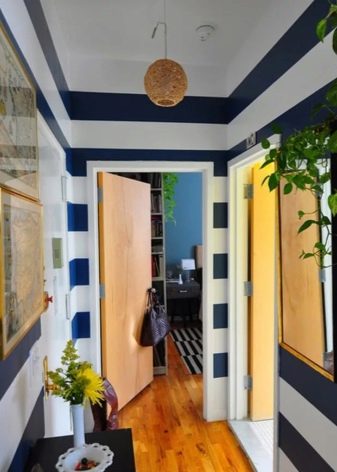
- vertical lines will visually raise the ceiling;

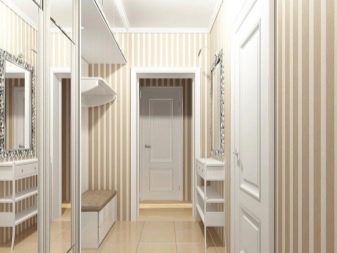
- it is not necessary to use a strip, a correctly directed pattern or ornament acts in the same way;


- gloss visually adds space, do not skimp on mirrors and reflective surfaces;


- a dark range narrows the room, so use such tones as accent, for example, brown fittings on beige furniture;


- the monochrome interior will perfectly liven up with colored lighting: green for relaxation, pink and gold for mirrors.


Beautiful examples
A white hallway is a universal solution.
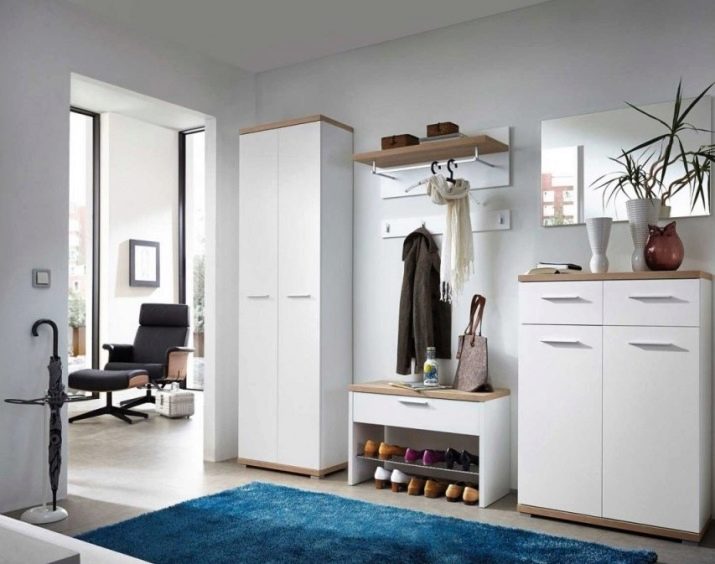
Black is an unusual and luxurious choice.

The yellow elements are very refreshing to the design.

Red and wine shades are well suited for expressive interiors.

Lilac and violet combine to create a mysterious and magical decor.

All shades of turquoise form an original sophisticated design.

Orange is best combined with a neutral beige palette.

See below for helpful tips on renovating the hallway and living room.








